About Each Card
The following list shows a small thumbnail of each card and a few lines which specify the details of the imagery used as well as a brief description of the archetypal meaning of the card. These meanings are also included on an insert sheet included with each deck, however the insert sheet does not include the source image credits information.
Return to Main - Return to Periodic Table - Continue to Orders
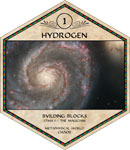
Hydrogen: Building Blocks. The image is of the Whirlpool Galaxy, courtesy of NASA and the Hubble Space Telescope. Stars shine because of nuclear fusion. Hydrogen is fused into heavier elements, thus releasing light, heat, and radiation. The Hydrogen card is associated with the Tarot card of The Magician. In the Tarot system, the Magician has on his table the four elements; earth, air, fire and water, from which he creates his reality. Hydrogen similarly is the raw building block for all matter.
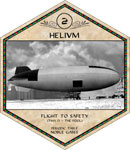
Helium: Flight to Safety. The image is of a naval airship, courtesy of NASA and the U.S. Navy. Helium is lighter than air and is non-reactive, so it can be used to lift airships without the fear of an explosion. The Helium card is associated with the Tarot card of The Fool, which depicts a young man who walks along the edge of a cliff, kept safe by his attentive dog. Another connection between Helium and the Fool can be found in how a lungful of Helium gas changes one’s voice to a humorous high pitch.
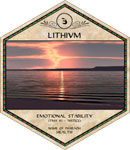
Lithium: Emotional Stability. A serene and peaceful beach with quiet waves represents the peaceful heart of the emotionally stable person. Lithium as a drug is given to emotionally disturbed patients to calm them. The Lithium card is associated with the Tarot card Justice because the arbiter represented acts without emotional influence. The sunset beach image was created by Calyxa using the 3d graphics program MojoWorld.
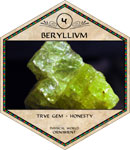
Beryllium: True Gem / Honesty. Beryllium is a key element in gems such as emerald and corundum. These stones are often clear and brilliant, but these qualities may not be apparent until the gem has been cut and polished. This photograph of beryl crystals is courtesy of Carl Mauritz.
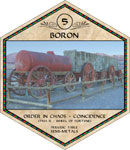
Boron: Order in Chaos / Coincidence. The image is of the 20 Mule Team Borax train, photographed by Calyxa. Boron is associated with the Tarot card The Wheel of Fortune, which is a reminder of constant change. The number 5 is associated with Eris, the goddess of the Discordians.
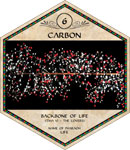
Carbon: Backbone of Life. The image shows a model of a DNA molecule, photographed by Colin Gregory Palmer of yotophoto.com. Carbon forms the main chain of the chemicals which make life possible. Carbon is associated with the Tarot card The Lovers. The double helix of DNA spirals together in much the same way as lovers entwine.
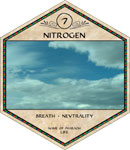
Nitrogen: Neutrality / Breath. Nitrogen makes up the majority of the atmosphere. Without the neutralizing effect of Nitrogen, the Oxygen in the atmosphere would be unbreathable. The image is of the Nevada Sky, photographed by Calyxa.
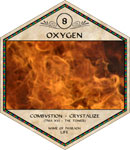
Oxygen: Crystallization / Combustion. Oxidizing is one of the most important chemical processes. Combustion fundamentally changes the properties of that which burns. Oxygen is associated with the Tarot card The Tower, an indicator of sudden change. The image of flames is a very small section cropped from a photograph from stockcache.com.
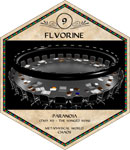
Fluorine: Paranoia. The image is of a tactical conference room in which powerful men plot the future of nations. The image was digitally created and rendered by Calyxa using the 3d graphics software Bryce. Fluorine is paired with the Tarot card of The Hanged Man, a reminder to look at situations from more than one angle.
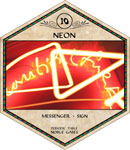
Neon: Messenger / Sign. Neon signs convey messages. Some are meant to warn or inform, while others are meant to distract. The image is a composite of cropped sections from photographs of two different neon signs: Abstract Neon by David Ellis and Neon Heart by Roswitha Schacht, courtesy of morguefile.com.
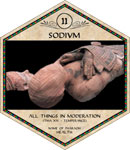
Sodium: All Things in Moderation. The chemical symbol for Sodium is Na, which comes from the name Natron, an ancient term for Sodium salts. Ancient Egyptians used natron salts in mummy preparation. The Tarot card Temperance is associated with Sodium. The source photograph of a mummy is by Ethan Wilding, with significant digital modifications done by Calyxa.
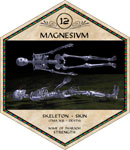
Magnesium: Skeleton / Skin. Magnesium is an important component of bone. The Tarot card paired with Magnesium is Death, because of the skeletal imagery. Out of death comes new life. The image of skeletons floating over a dark land was digitally created by Calyxa using the 3d graphics software MojoWorld and Poser.
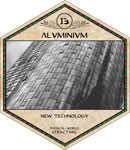
Aluminium: New Technology. Aluminium makes many modern structures and machines possible. This is the technology of the 20th century, technology that is relatively new, yet still well established and comfortable. The image is a small cropped area of a larger photograph of a building by Natascha Rausch, via morguefile.com.
![]()
Silicon: Network / Matrix. Silicon is the backbone of rock in much the same way Carbon is the backbone of life. Silicon represents a tying together, a matrix, a network, including the widespread use of computers. The image is a small cropped section of a larger photograph of chips on a silicon wafer courtesy of DHD Multimedia Gallery / Damon Hart-Davis.
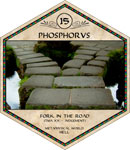
Phosphorus: Fork in the Road. The image is of a diverging path and refers to the making of a choice. This association comes from the fact that Phosphorus was the first element to be deliberately isolated. Phosphorus is associated with the Tarot card Judgment. The photograph of the forking path was taken by Rae Schwarz in the Japanese Tea Garden in Golden Gate Park.
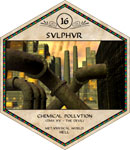
Sulphur: Chemical Pollution. The image is of a polluting factory, digitally created by Calyxa using the 3d graphics program Bryce. The Tarot association is The Devil, which is a card of voluntary weakness, bondage, and addiction.
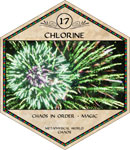
Chlorine: Chaos in Order / Magic. The image is of fireworks comes from the use of Chlorine salts to create green colored pyrotechnics, and magic is green. The image is a composite of cropped sections of two larger photographs of fireworks. The first is by Bob Ainsworth and the second is by Emily Roesly, both courtesy of morguefile.com.
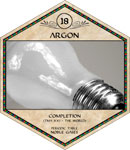
Argon: Completion. Argon is used inside of light bulbs due to its inert nature. Argon is associated with the Tarot card The World, which is the end of the Hero's journey. The image is a cropped section of a stock photograph of a lightbulb.
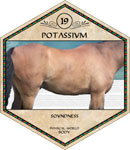
Potassium: Soundness. Potassium refers to the animal nature of one's body. The chemical symbol for Potassium is K, from the Latin kalium, meaning alkali. The image of the horse flank was cropped from a larger photograph by M. Whalley, courtesy of morguefile.com, with extensive digital modification by Calyxa.
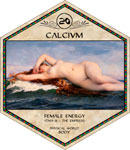
Calcium: Female Energy. Generally Calcium is associated with the bones, but it also is associated with women's health. The Tarot card of The Empress is a strong, compassionate, motherly figure. The image is from a 19th century painting of the Birth of Venus by Alexandre Cabanel, with extensive digital modification by Calyxa.
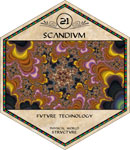
Scandium: Future Technology. Science is beginning to uncover the potential of Scandium in the creation of as of yet unknown technologies. The image is of a fractal, created by Calyxa using the Zfractal plugin for the 3d graphics software MojoWorld.
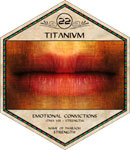
Titanium: Emotional Convictions. The texture behind the calm lips comes from rutilated quartz. These golden needles in quartz crystals are Titanium oxide. The Tarot association is the Strength card. This is a reminder to trust that one's emotions are valid. The source photograph for the lips is by Daniel Bayona, courtesy of morguefile.com, with significant digital modification by Calyxa.
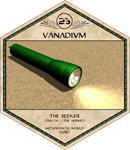
Vanadium: The Seeker. The Tarot card of The Hermit is associated with Vanadium. The image of a flashlight symbolizes this search for truth. The number 23 is symbolic of this search, being the number of coincidence. The image of the mini-flashlight was digitally created by Calyxa using the 3d graphics software Bryce.
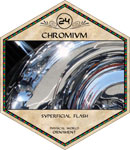
Chromium: Superficial Flash. Chrome plating can be seen as unnecessary gaudiness, but it also is a protective coating. The icing on the cake is one way to view Chromium. The image is cropped from a larger photograph of a motorcycle taken by Mark Miller, courtesy of morguefile.com.
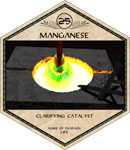
Manganese: Clarifying Catalyst. Manganese is added to glass to make it clear. The image is of a glassblowing furnace, with a glob of molten glass ready to be blown. The image was digitally created by Calyxa using the 3d graphics software Bryce.
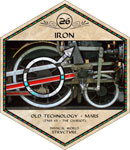
Iron: Old Technology. The image is of a locomotive, slang for which is 'iron horse.' Iron has long been used for technological creations. Iron is associated with the Tarot card The Chariot, which represents control over one's own path. The chemical symbol for Iron is Fe, which comes from the Latin name Ferrum. The source photograph of the Kingston Locomotive is by Steven Pinker, with digital modifications made by Calyxa.
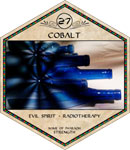
Cobalt: Evil Spirit / Radiotherapy. The name Cobalt comes from the German word 'kobold,' a malicious gnome-like troll who dwells underground. Cobalt is used to turn glass a deep brilliant blue. The image shows Cobalt glassware by Gracey Stinson, via morguefile.com, with scintillating rays digitally added by Calyxa, representing Cobalt's use in radiotherapy.
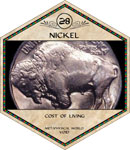
Nickel: Cost of Living. This is the money card. The image shows the back of the buffalo nickel, from a time period when that coin was still made of the element Nickel. The buffalo nickel photograph is courtesy of Peacepond / Victor Wedge.
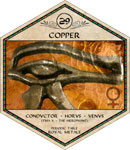
Copper: Venus / Horus. Copper represents the child in the father, mother, and child trio created by Royal Metals Gold/Silver/Copper. Copper has a female aspect of Venus and a male aspect of Horus. Copper is associated with the Tarot card of The Hierophant, which symbolizes one's standing within the community. The image is a composite of the venusian surface from JPL and the Eye of Horus by Belén Méndez courtesy of morguefile.com.
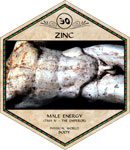
Zinc: Male Energy. Zinc is to men's health as Calcium is to women's health. The image is of the torso of a Greek statue. Zinc is associated with the Tarot card The Emperor, and represents leadership and power. The image is cropped from a larger photograph of a Greek statue by Clara Natoli, courtesy of morguefile.com, with extensive digital modification by Calyxa.
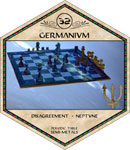
Germanium: Disagreement / Neptune. Germanium illustrates disagreement in part because of the disagreement in the scientific community surrounding its discovery and naming. The discoverer originally wanted to name it after the planet Neptune, hence the association with that planet. The image is a composite of the planet Neptune from JPL, and a chessboard by Stuart Whitmore, courtesy of morguefile.com. Digital modification and compositing done by Calyxa.
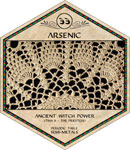
Arsenic: Ancient Witch Power. The movie title Arsenic and Old Lace has long been a part of popular culture, so the image representing Arsenic is of lace, found at www.fontplay.com/freephotos. Arsenic symbolizes the subtle powers of witches in history and culture. The Tarot card of The Priestess is associated with Arsenic, and is associated with intuition and secrets.
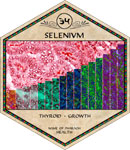
Selenium: Thyroid / Growth. Selenium is a vital element for the health of the thyroid gland, which regulates growth. The image is a photomicrograph of a thyroid gland courtesy of the Center for Disease Control, by Dr. Edwin P. Ewing, Jr., superimposed with a bar graph indicative of growth, created and composited by Calyxa.
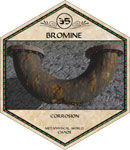
Bromine: Corrosion. Bromine is used in some water purification systems and in some medications. In its pure state, it is corrosive. The image is of a corroded drain trap, digitally created by Calyxa using the 3d graphics software Bryce. The Bromine card is a reminder to clean one’s pipes.
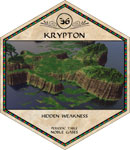
Krypton: Hidden Weakness. The name Krypton comes from Greek, for 'hidden.' The popular culture reference of Superman gives Krypton the connotation of weakness. The image is of an island, made from a collapsed human figure. The image was digitally created by Calyxa using 3d graphics software Poser and Bryce.
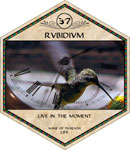
Rubidium: Live in the Moment. Rubidium is named from the strong dark red spectral lines which led to its discovery. Alchemists refer to a phase of transformation as rubedo, which relates to coagulation, the re-forming of the self after the dross has been burned away. The ruby-throated hummingbird embodies life in the moment of now. The image is a composite of two photographs. The hummingbird is by Bert Glibbery. The clock face is by Michael Connors. Both are courtesy of morguefile.com.
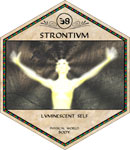
Strontium: Luminescent Self. The luminescent self is the part of the body that conducts the energy harnessed by Reiki healers. The image was digitally created by Calyxa using 3d graphics software Poser and MojoWorld.
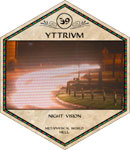
Yttrium: Night Vision. Yttrium was used to create the red phosphors in television tubes. Photographers and Astronomers use red light to read in the dark without compromising their dark-adjusted eyes. The Yttrium card also has a connotation of the ‘red mist’ of road rage. The image of night driving is courtesy of Carl Wragg, via morguefile.com. The texture overlay is a photograph of television phosphors by Calyxa.
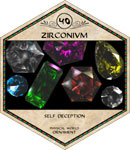
Zirconium: Self Deception. The positive side of self-deception is 'fake it until you make it.' Zirconium is a component of artificial gemstones. The image is also unreal; it is a computer generated rendering of gemstones, created by Calyxa with the 3d graphics software Bryce.
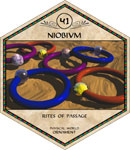
Niobium: Rites of Passage. Niobium is used in body jewelry because of its hypo-allergenic properties. The image is of body jewelry rings on a rocky surface, created by Calyxa using the 3d graphics software Bryce. Body piercing is a modern rite of passage with primitive roots.
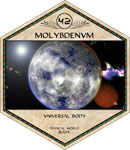
Molybdenum: Universal Body. The name Molybdenum comes from a Greek word for Lead. Beyond animal, female, male, and luminescent bodies there is the universal body. The image is of an unknown planet, moon, and distant star, created by Calyxa using the 3d graphics software MojoWorld.
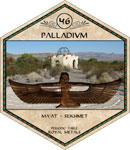
Palladium: Ma'at / Sekhmet. The image is a composite of the winged figure of Ma'at, Egyptian goddess of balance, and the Temple of Sekhmet located in Cactus Springs, NV, both photographs taken by Calyxa. Sekhmet is the goddess of fertility and the desert.
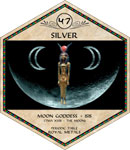
Silver: Moon Goddess / Isis. The association of Silver and the Moon is one of the most ancient. Silver is one of the three Noble Metals, as defined by chemists. The image of the moon is courtesy of JPL. The photograph of the Isis statue is by Calyxa.
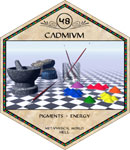
Cadmium: Pigments / Energy. This is the artist's card. Anyone who has suffered for their art understands why this card is in the Hell family. Also associated with Cadmium are the energies of the spectrum. The image of artists' pigments was digitally created by Calyxa using the 3d graphics software Bryce.
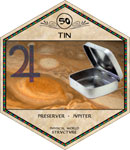
Tin: Jupiter / Preserver. Tin is one of the seven alchemical metals, known since ancient times. To keep something in a Tin is to preserve it. The chemical symbol for Tin is Sn, from the Latin name stannum. The image is a composite of a stock photo of Jupiter's red spot, and a tin box, courtesy of Ernest von Rosen.
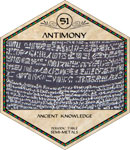
Antimony: Ancient Knowledge. The image is a photograph by Calyxa of some fabric printed with the text of the Rosetta Stone. The chemical symbol for Antimony is Sb, from the Latin stibium, meaning ‘to mark,’ as in writing.
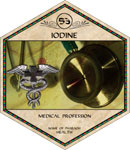
Iodine: Medical Profession. Iodine has long been used as a disinfectant. The image is of a stethoscope, taken by Michael Connors, and the caduceus, taken by Mary Tevington, which is an ancient symbol of medicine. Source photographs are courtesy of morguefile.com.
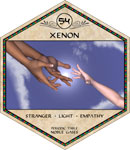
Xenon: Stranger / Light / Empathy. The name Xenon comes from the Greek word for 'stranger.' Xenon is also used in strobe flashes. Putting the concepts stranger and light together results in empathy, reaching out to strangers. The image of the reaching hands and light was digitally created by Calyxa, using the 3d graphics software Poser and MojoWorld.
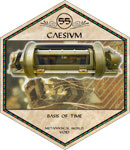
Caesium: Basis of Time. The image shows the first Caesium atomic clock made in the USA, courtesy of the Time Service Department, United States Naval Observatory. Below is a modern Caesium atomic clock which fits on a computer chip, courtesy of National Institute of Standards and Technology. A second is defined as the amount of time it takes for a Caesium atom to vibrate 9,192,631,770 times.
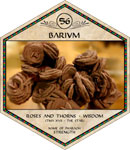
Barium: Rose and Thorns / Wisdom. Barium forms a mineral called barite, which crystallizes into rosettes, shown in the image. Wisdom is about knowing that there are thorns in amongst the roses, taught by experience. Barium is paired with the Tarot card of The Star. The barite rose source image is courtesy of ReBecca Hunt, with extensive digital modifications by Calyxa.
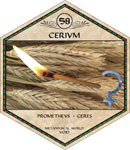
Cerium: Ceres / Prometheus. The goddess Ceres gave the gift of cultivation to humanity. Prometheus stole the knowledge of fire from the gods. The image shows stalks of barley and a burning match. Both photographs are courtesy of morguefile.com. The barley stalks photo is by Michael Connors and the burning match photo is by Ronnie Bergeron.
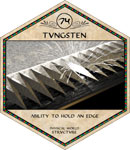
Tungsten: Ability to Hold an Edge. Tungsten has long been prized for its strength in holding a sharp edge. The sharpness of the Tungsten card can also refer to having a sharp tongue, of being too sharp for one’s own good. The image of an industrial Tungsten blade was digitally created by Calyxa using the 3d graphics program Bryce.
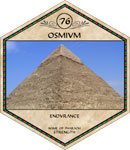
Osmium: Endurance. The symbol of endurance is the Great Pyramid at Giza. Osmium embodies endurance by its density, being one of the densest elements known. The photograph of the Great Pyramid is by Tatiana Tsokolova, courtesy of morguefile.com.
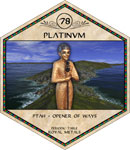
Platinum: Ptah Opener of Ways. Platinum is a catalyst, encouraging chemical reactions. The Platinum is unchanged. Similarly, Ptah is the Egyptian god who is the Opener of Ways. Ptah clears the path, and remains unchanged. The photograph of the Ptah statue is by Calyxa. The isthmus landscape was digitally created by Calyxa using the 3d graphics program MojoWorld.
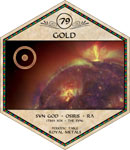
Gold: Sun God / Osiris / Ra. The association of Gold with the Sun is the most ancient elemental symbol in the deck. Gold is the pure goal of alchemists, the highest qualities which remain after all the dross and impurities have burned away. Gold is the third Noble Metal. The image of the Sun is from JPL and has been digitally modified by Calyxa.
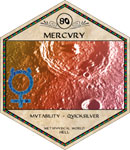
Mercury: Mutability / Quicksilver. Mercury has been associated with the planet of the same name since ancient times. Mercury represents sensitivity to one's environment. The image is of Brahms Crater on the planet Mercury, courtesy of NASA and digitally modified by Calyxa.
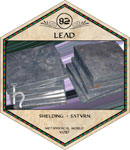
Lead: Shielding. Lead has been associated with the planet Saturn since ancient times. A Saturnine personality is one given to depression. The shielding aspect of Lead is a more recent connotation. The image is of Lead shielding plates, courtesy of Brian McDermott, super-imposed over an image of Saturn's rings, courtesy of NASA.
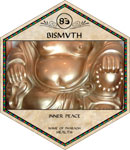
Bismuth: Inner Peace. Bismuth has been known since the Middle Ages. It has long been used in common stomach remedies. The image is of the belly of Buddha, cropped from a larger photograph of a Buddha statue found at morguefile.com attributed to a user known only as 'joeb'.
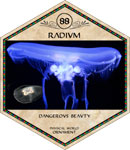
Radium: Dangerous Beauty. Radium was used in luminescent paint to mark clock and watch dials so that they might be read in the dark. Due to its radioactivity, the artisans who worked with Radium paints fell ill. The image of jellyfish represents beauty as well as danger. The fact that jellyfish are luminescent is also symbolic of Radium. Two photographs were used to create this image, one by Mark Miller, and the other by Roswitha Schacht, both courtesy of morguefile.com.
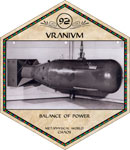
Uranium: Balance of Power. There is great power in Uranium and it can be used for peace as well as for war. The image is a photo of a reproduction of Little Boy, the second atomic bomb used in warfare. The photograph is from the National Security Archives.
Return to Main - Return to Periodic Table - Continue to Orders